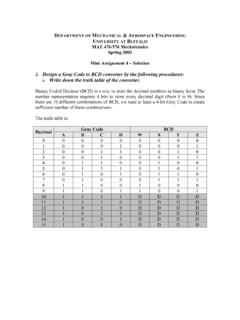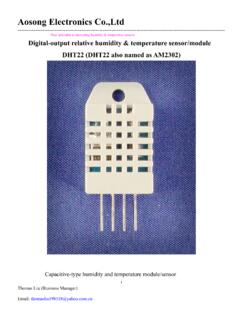Transcription of Polycarbonate (PC) - SENS
1 Polycarbonate (PC)Carlos BuitragoIntroduction to PolymersCE 435 OVERVIEWzIntroductionzStructure of PCzSynthesiszManufacturingzPhysical Properties of PCzApplications of PCzPC BlendszQuestionsINTRODUCTIONzPolycarbona te (PC), was first developed in 1953 by Bayer in Germany, and General Electric in the US independently. Its most popular trade name is LEXAN zPC is one of the high performance heterochain polymeric materials that comprise the family of engineering thermoplastics zPC is a good material choice in industry not only due to its characteristics, but also because its processing is environmentally friendly, and it can be recycledSTRUCTURE OF PCzA Polycarbonate molecule is composed by a Bisphenol A part and a carbonate groupzBisphenol A contains two aromatic rings, which are responsible for PC s stiff backbone zThe Bisphenol A group also contributes to PC s inability to crystallize. This amorphous structure gives the polymer its particular transparencyLG-DOW ( ).
2 Molecular structure of Polycarbonate . The Characteristic high glass transition temperature (Tg = 145 C) of PC is caused by the minimal molecular rotation about the bonds SYNTHESISPC is most often synthesized from Bisphenol Aand phosgeneby a step-growth polymerization in which Cl-ions are eliminated every time the monomers react. This kind of step-growth polymerization is often called a condensation processPolymerization Steps1. The Bisphenol A groups are reacted with proton acceptors such as NaOH to obtain the polymerization functional groupsPolymerization steps (Cont d) deprotonated Bispohenol A reacts with Phosgene and a catalyst at temperatures between 25 and 35 C. This way, a Polycarbonate monomer is formed, and the catalyst (often times Pyridine), is eliminated along with the chloride anionPolymerization steps (Cont d) order to react more Bisphenol A and phosgene into the chain, chloride anions are always eliminatedIn another approach, Diphenyl Carbonate (R-O-CO-O-R) and Bisphenol A, can be reacted at temperatures between 180-220 C to yield PC and a phenol molecule.
3 This process results in more impurity, and is more expensive because higher temperatures are necessaryMANUFACTURINGP olycarbonate is transformed from pellets into the desired shape for its intended application by melting the Polycarbonate and forcing it under pressure into a mold or die to give it the desired shape depending on the application. This process is repeated thousands of timesExtrusionThe molten PC is passed through a die that gives the material its final shape. After this, the melt is cooled rapidly. Long pipes and sheets are created by this processMoldingThe PC melt is pressed into a mold with the defined shape of the final product. The melt is then cooled inside the mold. This process is ideal for specific parts such as automotive and computer partsPHYSICAL PROPERTIES OF PCzIt maintains good mechanical properties between -40 F and 280 FzHigh strength that makes it resistant to impact and fracturezIt can be easily colored, it s non-toxic, and can be absolutely transparent up to 2 In.
4 In widthzPC also features high electrical and heat resistancezIt is biologically inertzReadily recyclable and cost effectiveAPPLICATIONS OF PCzPC s outstanding strength makes it suitable for bullet-resistant or shatter-resistant glass applicationszPC s relatively low weight in comparison to other high strength materials and its high ductility make it attractive to be used in lenses and windowszIt has also been used as a flame retardant and an electrical insulatorzSmall filters for the extrusion of small particleszCD s, DVD s. Automotive, cell phone, and laptop parts. PC BLENDSPC can be blended to enhance its properties:zPC/ABS blends exhibit high ductility and impact strength at temperatures below those of pure PCzPC tends to scratch easily, Silicone- Polycarbonate copolymers can yield a hard thermoplastic that doesn t get scratched. Many more properties can be achieved depending on the compositionQUESTIONSREFERENCESR odriguez, F.
5 , Cohen, C., Ober, C., Archer, L., Principles of Polymer & Francis, New York, London, 2003 LG-DOW ( ). Properties of Plastics Federation ( ). Polycarbonate PC. , M., Johnson, K. Materials and design Butterworth Heinemann, Oxford, 2002 Association of Plastic Manufacturers (n,d.). , definition and much more (n,d.).Synthesis of Polycarbonate .










